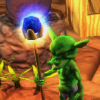Yes, this image is a perfect fit for baked lighting. Yo can do this without any worries about performance or hard implementations :)
To make it work, easiest way is to add nonoverlapping UVs for a single texture for the whole model (UV unwrap).
Any 3D modeling packege should be able to bake lighting to texture using this UV map for you.
How is radiosity different from AO?
Radiosity assumes perfect diffuse surfaces everywhere and calculates the light interreflections from each surface to each other.
Because there are no reflections, surface light is view independent, so everything can be precomputed to a single color per lightmap texel.
AO looks for blocking near geometry. More blocking -> less chance to receive light -> darken the surface. (Typical darkening in corners)
Looks best in combination with a enviroment mapped light source, e.g. a prefiltered image with sky and sun that gives light on given surface normal.
View dependent too, but not physically correct.
Seems the Mario images uses AO, because i can't spot any color bleeding.
Comparing AO / radiosity with simple direct lighting there's a big difference:
Radiosity makes the image brighter with every additional bounce of light (reality has infinite bounces)
AO can only make the image darker.
GI = Everything. Similar to radiosity, but also handling non diffuse materials (reflections, refractions, scattering).
Because Reflections ar not view independent, it's not possible to bake it except for bump mapping or very glossy reflection demands (directional light maps).












